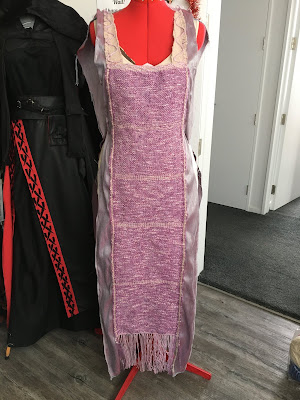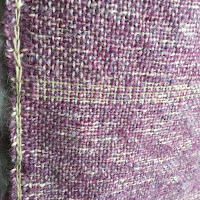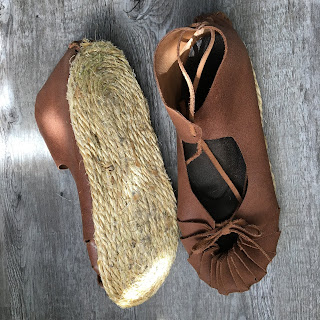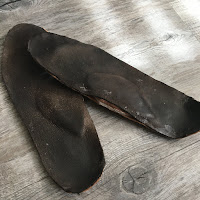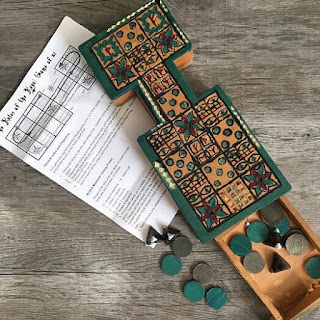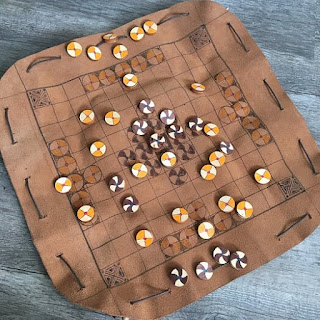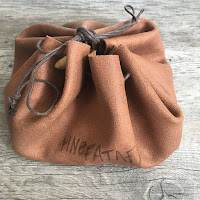This hood is presented for the categories The Neck Best Thing, Cover Me, One Metre Material Project (wool fabric), Counting (on) Sheep.
I anticipated needing some additional warmth around my head and neck for the Fiery Knights event, but I didn’t have anything as I’m not a fan of hats or headwear. I decided the most appropriate period choices seemed to be the Hedeby hood or the Skjoldehamn hood (whether or not the Skjoldehamn hood is Viking or Sami remains a matter of debate, however as both Viking and Sami occupied the area at the time (late Viking-period), some concordance may not be out of the question). I wanted the hood to go with the red wool Viking coat I made for cold nights at camp, and remembered that somewhere I had scraps of that fabric. Upon excavating my fabric stash, I found I had two strips of the fabric, each about 90x30cm. This ruled out the Hedeby hood, but was pretty much the same size as the fabric for the Skjoldehamn hood. I decided to make the hood as close to the original as possible to the original to better understand how the period garment was constructed and might have been worn. The construction of this hood is not quite as simple as it may seem, however I could easily have completed the garment in less than one day if I’d had the opportunity to do so.
The original hood is comprised of a square of wool about 60×60 cm, which was folded in half and sewn together along the top and down the back (of the head), with a slit at the lower front and open seam at the lower back into which square gores approx 30×30 cm were inserted, and the front of the hood was slit open for the face opening. Since I had two strips 90×30 I had the right amount of fabric, but the hood had to be sewn together (rather than slit open) at the front as well as the back. The person who had worn the original hood was probably an adult around 5 ft high (just a few inches shorter than me) so I thought I’d make the hood the same size, but with slightly smaller seam allowances. The finished hood is snug and comfortable but not tight, and covers the top of my shoulders, chest and back just fine, so the sizing seems good. I do find it a little difficult to lower and raise the hood but that is largely due to my ponytail.
I constructed the hood as close to the original as information allowed, e.g. all the seams were sewn from the outside, by turning the seam allowances in along the top and back of the head of the hood, and along the gores and sewing the outside of the seam with in an overcast stitch. The original was described as a non-decorative stitch; I used some wool sewing thread that was a close match for the fabric colour so the resulting seam was definitely not decorative, and mostly invisible. All the seams in the hood other than along the top of the head were then opened out, and stitched from the outside with an alternating, slightly diagonal running stitch which was also non-decorative. This essentially flattens out the seam allowances and holds them flat on the inside of the hood. This is an effectively way to ensure they don’t stick out and catch on the wearer’s hair.
Along the top of the head of the original hood there are several rows of running stitch that go across the top of the head, and then “dip” to follow the curve of the back of the head, creating what some call a “cockscomb” effect. It has been speculated that this was intended to make the hood sit better, and further forward on the head. I replicated these stitches, although I did not take the final line of stitching so deep at back as the original so as to accommodate my topknot ponytail. This “cockscomb” did indeed seem to keep the hood more snug and more forward, but this might just have been because it fit closer around the head. We will never know if this was intended in the original, or was this originally done to e.g. “downsize” the hood to fit the specific wearer.
I had to depart from the original construction technique in needing to overcast all raw edges (other than the top seam which was enclosed inside the lines of running stitch) as my fabric was quite “sleazy” (thanks to Baroness Eleonora for this weaving term meaning a ” fabric with a very loose weave which has a tendency to come apart at the slightest provocation”). I used a simple overcast stitch again in the same thread so this is largely inconspicuous.
At the face opening of the original hood a narrow seam allowance was turned in, and a non-decorative cord (i.e. not a contrasting colour) was couched around the edge of the seam allowance of opening on the inside with a decorative couching (i.e. contrasting) stitch. The original decorative stitch changes colour at one point, as if the maker ran out of the first coloured thread. I choose to use one decorative colour (in this case the pale gold wool that was used to decorate my coat) as it would otherwise look odd to modern eyes. It seemed a shame to miss out on the opportunity to use a decorative cord around the face as well (other garments in the original outfit have some highly decorative touches, and the hood seems somewhat under-decorated by comparison), but I found in my stash a cord of a slightly different red wool which I’d made for another project. This was then subtly decorative, hopefully satisfying both me and the original.
The lower edge of the original hood was not folded under, merely overcast along the cut edge. My sleazy fabric was not stable enough to do this, so I had to fold under a small hem. One source says the original hem was overcast with a stitch that was “parallel to the thread”, so I used a simple blanket stitch. In the original this overcasting is not decorative, but I used the pale gold-coloured wool again to match the decoration on my coat as by this time the hood was looking a bit plain and not very “matchy” with the coat. I’m still not sure how I feel about this and may yet change that.
The original hood has two cords attached to the outside, described as being placed “under the ears”. There is speculation among archaeologists and reenactors as to what these cords are for (e.g. pulling the hood closed around the face, pulling it open by tying at the back of the neck / head) but it was noted that there is little wear apparent so it is assumed that the cords on this particular hood were not much used. I did have some cord left over from my coat which just happened to be the right length for these. I pinned the cords on to the hood and tried the hood on, pulling the cords both forward and back. I decided I didn’t really have much need to pull the hood closed (no snow storms expected) or keep it open (I preferred to pull it down around my neck for temperature control and to avoid impeding my peripheral vision), and since the cords really annoyed me dangling either side of my head I took them off and put them in the naughty corner, from where they may or may not be attached at a later date.









